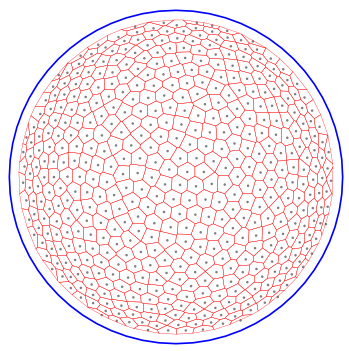A few notes about how it was made…
Obviously, the shapes weren’t designed by hand. I wrote a bunch of code.
The first step was to generate a random, deliberately irregular, approximately-spherical polyhedron. I used a simulated annealing algorithm to get a set of not-quite-evenly-spaced points on the sphere. The intersections of the points’ tangent planes became the sides of the polygonal faces. (The projection of this onto the sphere is actually a spherical Voronoi diagram.)

Note that the V-shape of the kerf doesn’t control the curvature of the sphere (more accurately, the irregular polyhedron). The geometry is determined by the angles at the vertices (see Wikipedia:Angular Defect).
For the picture, I started with this (flat) AI-generated image:
Treating it like a top-down view (orthographic projection) of a hemisphere, I then computed the images for the pieces, using a separate gnonomic map projection for each piece.
I laid out the pieces separately (it took 8 letter-sized sheets) and cut them with a kerf adjustment. The scored hints on the back were automatically computed, and I used the digits from the Hershey font.
